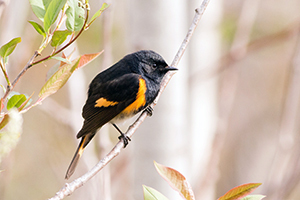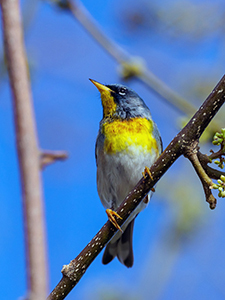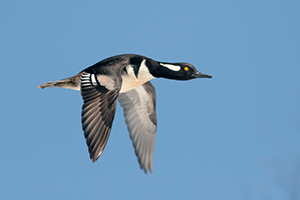Birding trails developing across Michigan
By CASEY WARNER
Michigan Department of Natural Resources

While some Michiganders might be looking and listening for the return of migrating birds as a sign that this brutal winter has made its long-awaited swan song, many others are doing so in pursuit of a popular pastime.
More than 45 million Americans enjoy birdwatching – called birding in today’s vernacular – according to the 2016 National Survey of Fishing, Hunting, and Wildlife-Associated Recreation produced by the U.S. Fish and Wildlife Service.
Along with other wildlife watchers, birders contribute nearly $80 billion to the U.S. economy annually.
Young people are among those adopting birding as a hobby. One such young man has parlayed an interest in birds into a unique educational experience that will benefit others traveling to the eastern Upper Peninsula in search of birds.
Evan Griffis, a senior at Newberry High School, spends two hours a day working with Michigan Department of Natural Resources wildlife staff out of the DNR’s Newberry office as part of a job-training program his school offers.
The young man – who Kristie Sitar, a DNR wildlife biologist who works with Griffis, called “a pretty big-time birder and an extremely talented kid” – spearheaded the effort to develop the new Silver Creek Birding Trail.
Expected to open to the public in the next few months, this three-season trail is located on state land northwest of Newberry in Luce County.
|

Griffis, who said he has had an interest in birds from a young age and has been looking for them and keeping lists of the birds he’s seen as a hobby for the last six years, has been working with the DNR throughout the school year.
“In the fall, we started driving to analyze habitat and scout different spots for trail stops,” Griffis said. “We were looking for diverse habitat that attracts diverse bird species.”
According to a brochure that Griffis wrote and designed over the winter, the trail “features diverse forest types host to numerous breeding and migrant bird species,” and visitors will be able to “bird from the road or hike down short trails to fully enjoy this natural area.”
Centered around Silver Creek Pond, the 9-mile birding trail features nine posted stops along the road, with short hiking trails at four of the markers.
“It runs through numerous different managed habitats and encompasses a variety of bird habitat,” Sitar said.
The trail highlights the temperate and boreal forests of the Upper Peninsula and features both mature and regenerating forest, as well as bogs, clearings and ponds.
|

Generally accessible with a two-wheel-drive vehicle during the spring, summer and fall (not accessible by car in the winter), the trail offers opportunities to see breeding birds through the summer and migrants in the spring and fall.
Visitors can expect to see a wide range of birds along the trail, such as American redstarts, winter wrens, blue-headed vireos, hooded mergansers and magnolia warblers – just to name a few.
Trail signs and an information kiosk, with a box for visitors to leave comments, will be installed in the next few months.
The eastern Upper Peninsula, which also features a variety of other birdwatching sites along the Superior Birding Trail, draws in birders from other regions and across the state.
“We have unique and special habitat you don’t find anywhere else,” Griffis said.
With the growing popularity of birdwatching as a pastime, birding trails are developing around the state.
“Michigan’s a great place for birding,” said Pam Grassmick, project coordinator for the Beaver Island Birding Trail. “It’s getting to be known as a great birding destination, especially for rare and unique birds like piping plover and Kirtland’s warbler.”
|

The Beaver Island Birding Trail features 35 sites, some of them intended for observation from the road and others with walkable trails, and offers opportunities to see an array of migrating and resident birds.
“The island is situated in a major flyway, so we get many birds passing through, but some stay to nest,” Grassmick said.
Visiting birders can explore the trail on their own or attend the island’s annual Warblers on the Water event, coming up May 24-26, which includes guided birding trips and presentations.
“The reason we have the birds is we have high-quality habitats, including wetlands, boreal forest and interior lakes,” Grassmick said.
The Beaver Island Birding Trail encompasses more than 12,000 acres of public land, including state-owned land administered by the DNR.
“The DNR Wildlife Division has been a major partner in the development of the trail,” said Grassmick, who talked about the importance of actively managing habitat.
“Conservation doesn’t just happen.”
|

The DNR Wildlife Division fiscal year 2018 annual report detailed some of the successes of conservation partnerships on Beaver Island: “Over the last year, partners worked to clear land trails, opened a new non-motorized water trail around Beaver Island, surveyed for and treated invasive plants and insects, and developed a landscape-level plan. These projects are the result of residents, local and tribal governments, cultural and natural resource experts, and non-governmental agencies partnering together.”
More information about birding trails around the state is available on the Michigan Audubon birding trails webpage.
For those seeking a more guided birding experience, the DNR is offering spring birding tours at its Wetland Wonders – or managed waterfowl areas – starting March 30. Highlights may include diving and dabbling ducks in full breeding plumage, trumpeter and tundra swans, osprey, bald eagles, sandhill cranes and many more.
“As a staff member, I enjoy attending the spring birding tours, because they bring together people of all skill levels and ages. It’s great to watch someone experience their first bald eagle or snowy owl sighting,” Holly Vaughn, DNR wildlife communications coordinator, said. “Plus, the ducks look spectacular in their spring finery. It’s a really good time for everyone.”
Learn more about birding and other wildlife watching opportunities at Michigan.gov/MiWildlifeViewing.
|
Check out previous Showcasing the DNR stories in our archive at Michigan.gov/DNRStories. To subscribe to upcoming Showcasing articles, sign up for free email delivery at Michigan.gov/DNR.
/Note to editors: Contact: John Pepin, Showcasing the DNR series editor, 906-226-1352. Accompanying photos and a text-only version of this story are available below for download. Caption information follows. Credit Michigan Department of Natural Resources, unless otherwise noted.
Text-only version of this story.
American redstart: American redstarts are one species that visitors will be able to find along the Silver Creek Birding Trail, north of Newberry in Luce County, which is set to open to the public later this year. (Photo courtesy of Evan Griffis)
Habitat 1 and Habitat 2: The three-season Silver Creek Birding Trail, where visitors will be able to enjoy birding from the road or by hiking down short trails, features diverse forest types that host numerous breeding and migrant bird species. (Photo courtesy of Evan Griffis)
Hooded merganser: Hooded mergansers and wood ducks can be spotted on the water of Silver Creek Pond, a stop on the Silver Creek Birding Trail. (Photo courtesy of Evan Griffis)
Magnolia warbler: The conifers around Silver Creek Pond, one of nine stops on the Sliver Creek Birding Trail, make good habitat for migrating magnolia warblers as well as other warblers. (Photo courtesy of Evan Griffis)
Map: A map showing the stops, and variety of featured habitat types, on the Sliver Creek Birding Trail.
Northern parula: The northern parula is one of many migratory bird species that can be spotted along the Beaver Island Birding Trail in Charlevoix County. (Photo courtesy of Darrell Lawson)
Piping plover: Rare and unique birds like the piping plover, shown here, and Kirtland’s warbler make Michigan a popular birding destination.
Pointe Mouillee: A birder enjoys the view at Pointe Mouillee State Game Area, located primarily in Monroe County, one of Michigan’s seven Wetland Wonders. These managed waterfowl areas will host a series of spring birding tours beginning March 30./
|